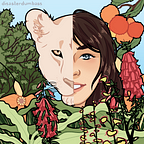SCIENCE STORIES | Plants
How Many Giants Does the Rainforest Have?
When it comes to large trees, it turns out there are a lot more out there than we thought.
Large trees are a common ingredient in the collective imagination of “a rainforest”: large trees, lots of humidity, twisted lianas, a monkey calling…
But it turns out we know surprisingly little about those giant trees, despite their important role within the rainforest.
One of the reasons we know little about them is that regular vegetation sampling takes place on small scales. When doing a vegetation survey, botanists establish a few small plots and survey the plants found within. A collection of these plots allows them to get a good idea of what is happening at the environment level.
However, these small plots are likely to underestimate large trees. Due to their large size and their relatively infrequent occurrence, it is likely that only a few large trees make it inside these small plots.
A few years ago, a team of scientists decided to change things up. They wanted to know more about those large giants that dot the rainforest. They wanted answers to their questions like:
- How many tree species can get that big?
- Which species are the most abundant among these large trees?
Why study large trees specifically?
This fascination with large trees is not purely aesthetic or academic. Large trees play an important role in the environment. Aside from being gigantic storages of carbon (literally keeping carbon away from our atmosphere), the trees provide food for both humans and animals.
Some trees provide edible fruits or provide medicinal substances. Others are used as forage for edible caterpillars, or have symbiotic relationships with edible fungi, like chanterelles. They are also resources for bees, which make honey.
In the words of Sydney T. Ndolo Ebika, a co-author of this study:
“The Congo Basin is also home to large mammals such as forest elephants, western lowland gorillas and chimpanzees. These ‘megafauna’ or large animals rely on the largest trees for food, shelter and protection, so the protection and conservation of these big forest trees is crucial to the survival of these iconic species.”
Previous studies have found that large rainforest animals like chimpanzees, gorillas, and forest elephants are linked to the state of the forests and the larger trees. Areas with undisturbed forests and taller trees have more of these large and charismatic forest animals.
If you want different results… do things differently!
Rather than have the typical 1 ha plot for their vegetation sampling, the authors of this study decided to study plots ten times bigger! They hoped this would give them a better picture of just how many large trees there were in the rainforest.
The study took place in the Sangha Trinational in central Africa, a UNESCO Natural World Heritage site. Within the Sangha Trinational, they randomly assigned sections of the forest to plots. Then, they identified every single tree with a diameter above 80 centimeters.
Hidden tree diversity in plain sight
They identified 1.221 individual trees belonging to 92 different species: that is a lot more than the number of species scientists had previously estimated using smaller plot samples.
Since the Sangha Trinational area has over 400 tree species in total, this means that almost 25% of those species have the potential to reach towering sizes.
Scientists were surprised to find which species was the most common amongst the tree giants. The honour belonged, without a doubt, to Entandrophragma cylindricum, a relatively rare tree when trees of all sizes are sampled (the majority of which are much, much thinner).
This tree is usually known as Sapele, a well-known tree in the timber industry. This species is used as an alternative to mahogany.
The COVID-19 pandemic has impeded the researchers from continuing their study, but they plan to return to their plots. One of the aims of this study was to monitor the growth, recruitment and mortality of these giant trees in the long-term.
David B. Morgan, a co-author in this study, added:
“The wellbeing of wildlife, forests and local human populations are inextricably linked in the forests of northern Congo and long-term research studies like this one are critical for identifying threats and developing policies to address them.”
Thank you for reading.
You can also inspire others to experience the beauty of this lovely planet.
Just click the below image and be a writer for The Environment
